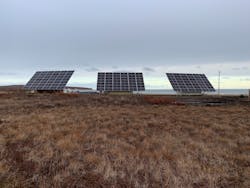97% Renewable Microgrid to Replace Fire-Vulnerable Line in California During Wildfire Season
A 97% renewable microgrid will allow Liberty Utilities to de-energize four miles of transmission line located in a remote Sierra Nevada location during wildfire season in California.
The microgrid, from BoxPower and owned by Liberty Utilities, a regulated utility with about 50,000 customers on the West side of Lake Tahoe, is made up of 20 kW of solar, 68 kWh of storage and propane backup.
It’s expected to use the propane only 3% of the time. Ground has been broken and the microgrid is expected to begin operating in October, said Anderson Barkow, co-founder and CFO, BoxPower, which was a finalist in Microgrid Knowledge’s Greater Good Award competition.
Achieving the 97% renewable penetration is possible due to the utility’s willingness to acquire larger amounts of solar, he said. Generally, BoxPower’s microgrids are 80% to 95% renewable.
The microgrid was designed not only to address wildfires in the vulnerable Sierra Nevada mountains, but another natural phenomenon: heavy, wet snow that often piles up all at once, he said.
Quick shipment
BoxPower’s design ensures that the microgrid equipment can hold 375 pounds per square foot of snow. BoxPower also increased the tilt of the solar panels to a 60-degree angle to ensure snow could slide off of them, he said.
A container design will allow the microgrid to be installed quickly.
“It’s at our warehouse now; we will ship up there this week and install on the site quickly,” said Barkow. “Because of the design constraints, it should take five days. “Usually it takes a single day.”
The risk of wildfires in California, along with public safety power shutoffs from utilities like Pacific Gas & Electric have helped boost business for BoxPower and others.
The BoxPower microgrid designed for Liberty Utilities will serve the University of California Berkeley Sagehen Creek Field Station.
The line to the field station, which includes 90 poles, will initially be de-energized from June through December, but plans call for it to be fully de-energized at some point, when additional generation is available, said Barkow.
BoxPower was awarded the project after responding to a request for offers issued by Liberty earlier this year. Its experience working in remote environments helped the company land the project. BoxPower has installed two solar plus storage microgrids in Alaska that involve NANA, a regional corporation consisting of about 14,500 Iñupiat shareholders, or descendants, who live in or have roots in the region. BoxPower submitted its proposal without having visited the site.
“It was all a virtual site walk,” said Barkow. “We put the bid together before we had been there.” The company did a detailed site walk through a virtual tour.
Liberty Utilities saving $2 milion
Liberty Utilities, a subsidiary of Algonquin Power and Utilities, first began looking at ways to harden the line against wildfires, but discovered that the options — including upgrades such as installing covered conductors to its transmission lines that run through mountains to the remote Sagehen Field Station — were expensive, said Barkow.
It would have cost about $3 million to harden the entire 4-mile line, which has 90 poles and serves Berkeley’s Sagehen Creek Field Station.
By avoiding having to upgrade the line, the utility expects to save more than $2 million over the lifetime of the microgrid, he said.
The microgrid will initially be connected to the grid, and includes real-time monitoring, remote diagnostics, automated alert and reporting. It will be capable of peak demand reduction, time-of-use optimization, data consolidation and aggregation for resale, and virtual power plant capabilities, Barkow said.
DIY microgrid
In addition to the California and Alaska microgrids, BoxPower has installed a solar plus storage system at a resident’s off-grid home and home office in Pahoa Hawaii. BoxPower designed a system to meet the customer’s needs and built it in California. The customer installed the microgrid by herself, following BoxPower’s instructions.
The system included a 21 kWh lithium ferrous phosphate battery system, and 12 kW battery inverter pre-wired inside a 4’ x 8’ metal enclosure, with a 3.5 kW solar PV array mounted on top.
Modular microgrids cathing on
Modular, plug-and-play microgrids like BoxPower’s are growing in popularity.
Modular microgrids have the potential to become the the majority of systems installed by 2029, says Peter Asmus, research director at Guidehouse.
“The plug and play microgrid market is being driven by an increasing number and duration of outages, high costs to maintain rural transmission lines, especially in wildfire prone areas, and decreasing costs of inputs due to the plug and play model. These factors have lead to five times growth at BoxPower this year versus last year.” said Barkow.
Track news about microgrids used as non-wires alternatives. Subscribe to the free Microgrid Knowledge newsletter.
About the Author
Lisa Cohn
Contributing Editor
I focus on the West Coast and Midwest. Email me at [email protected]
I’ve been writing about energy for more than 20 years, and my stories have appeared in EnergyBiz, SNL Financial, Mother Earth News, Natural Home Magazine, Horizon Air Magazine, Oregon Business, Open Spaces, the Portland Tribune, The Oregonian, Renewable Energy World, Windpower Monthly and other publications. I’m also a former stringer for the Platts/McGraw-Hill energy publications. I began my career covering energy and environment for The Cape Cod Times, where Elisa Wood also was a reporter. I’ve received numerous writing awards from national, regional and local organizations, including Pacific Northwest Writers Association, Willamette Writers, Associated Oregon Industries, and the Voice of Youth Advocates. I first became interested in energy as a student at Wesleyan University, Middletown, Connecticut, where I helped design and build a solar house.
Twitter: @LisaECohn
Linkedin: LisaEllenCohn
Facebook: Energy Efficiency Markets

